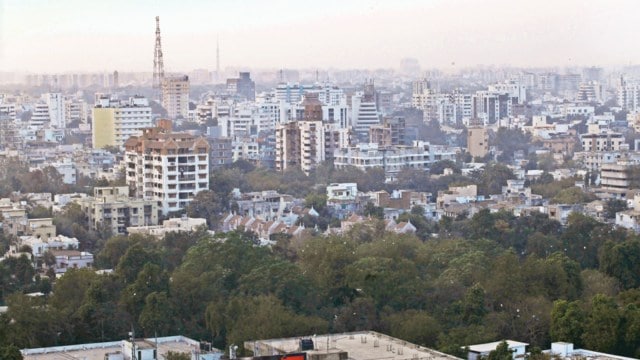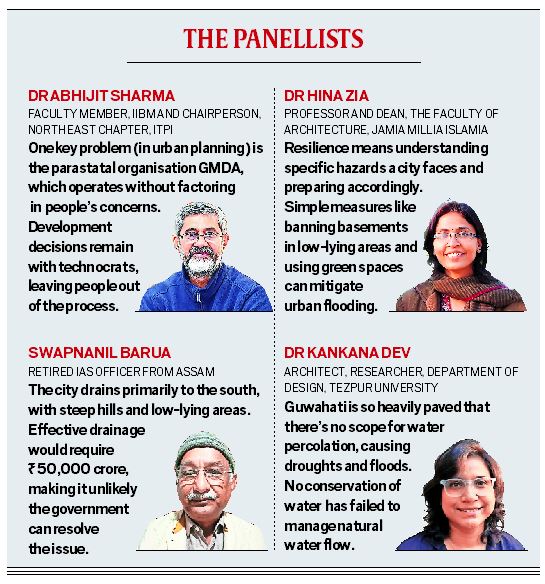IE THINC Fifth Edition: ‘Sponge-city concept may mitigate flooding’
At the fifth edition of the IE Thinc: CITIES series, presented by The Indian Express with Omidyar Network India and moderated by Sukrita Baruah, Principal Correspondent, panellists discussed how Guwahati, a growing urban centre, can tackle floods and droughts
 Inclusive development of Indian cities may appear chaotic and unlike the Western imagination of smart cities.
Inclusive development of Indian cities may appear chaotic and unlike the Western imagination of smart cities. At the fifth edition of the IE Thinc: CITIES series, presented by The Indian Express with Omidyar Network India and moderated by Sukrita Baruah, Principal Correspondent, panellists discussed how Guwahati, a growing urban centre, can tackle floods and droughts
On issues in urban planning
Dr Abhijit Sharma: Citizens of Guwahati face anxiety at night as they head home, unsure if they will make it on time, given the infrastructure mess. Despite town planning efforts, the city faces serious issues. One key problem is the parastatal organisation GMDA (Guwahati Metropolitan Development Authority), which operates without talking to peopleor understanding what they need. The municipal corporation, which should be responsible for urban planning under the 74th Amendment, is sidelined, leaving a governance gap. Development decisions remain with technocrats and bureaucrats, keeping citizens out of the process.
Additionally, Guwahati’s urban development is heavily influenced by brokers. They have actually sub-let land and plots in their control and built Guwahati in a haphazard manner we see today. In the master plan, 0.02 per cent of the space was kept for open spaces. All of these have been encroached upon.
Furthermore, the drainage system is inadequate due to poor planning in present times and incomplete execution of the comprehensive development plan of 1972. While there are positive signs, such as the recent adoption of town planning schemes and a renewed focus on drainage, much work remains to fix the city’s fundamental flaws and get things going.
A drainage plan from 1972, which was conceptualised by the Calcutta Metropolitan Development Authority, was not fully implemented due to resource limitations. This led to a patchwork drainage system. Despite these challenges, there are positive signs: the government recently adopted town planning schemes in Guwahati and other parts of the state, signalling progress in land management. Additionally, if we revisit the drainage plan and focus on major channels, that approach could help improve water flow. These are initial steps but there is potential for further positive development.
On building a climate-resilient city
Dr Hina Zia: Whether it’s Guwahati, Delhi, Bengaluru or any small town, resilience must be integrated with planning. Extreme events are increasing, both globally and locally, but countries are not doing enough. My work on the ACCRN project in Guwahati identified gaps in policy and planning, with a holistic plan submitted to the development authority. However, projects have been taken up piecemeal, with many still incomplete, reflecting a decade of little progress.
Resilience means understanding the specific hazards a city faces and preparing accordingly. For example, in Guwahati, slope analysis is crucial to avoid construction in flood-prone areas, while simple measures like banning basements in low-lying areas could prevent flooding. Enhancing drainage systems and using green spaces as natural solutions can also mitigate urban flooding.
Beyond infrastructure, building the capacity of local people and institutions to respond to disasters is equally important. Governance should involve not just formal systems but also NGOs, CBOs and local communities. Despite knowing the problems and potential solutions, progress has been slow and there is still a need for course correction.

On roadblocks in implementation
Swapnanil Barua: Guwahati’s ridge, little known to many, lies near the district collector’s office and marks the city’s drainage divide. The city drains primarily to the south, with the railway line forming its drainage boundary. Originally, the British warned against developing Guwahati, labelling it the most unhealthy station in Assam due to poor drainage. The city was once a mix of hills and wetlands, with water draining slowly through natural outlets like Silsako Beel, Burulu River and Dipurbil, which are now obstructed.
Guwahati’s terrain, with steep hills and low-lying areas, makes effective drainage a challenge. The city would need an estimated Rs 50,000 crore for infrastructure interventions, including pumping stations, to manage the natural water flow. This is half of Assam’s budget, making it unlikely the government can tackle the issue.
The Chief Minister recently acknowledged that bigger drains and land acquisitions would be needed, even suggesting demolishing buildings, including institutions, to reclaim space. However, solving Guwahati’s waterlogging woes will require restoring wetlands and sponges to their pre-1960s state or leveraging technology for water management. The current drainage system is insufficient.
Furthermore, Guwahati’s hills have sharp inclines, making construction difficult. The British realised this and moved Assam’s capital to Shillong by 1874. They assessed that Guwahati was better suited as a transit point than a permanent settlement. Today, reclaimed wetlands, which have been redeveloped, are worsening water management issues.
The city’s flooding problems are exacerbated by the lack of a crisis management group and essential data on flood-prone areas. Until planners account for the geography and restore Guwahati’s natural drainage systems or shift development to the flatter northern bank, akin to planned satellite cities like Noida, near Delhi, or Rajarhat, near Kolkata, the city’s flooding issues will persist. Even a short rain can result in heavy waterlogging, highlighting the urgent need for comprehensive, sustainable urban planning for Guwahati.
The breakdown of the community is also affecting civic amenities. Therefore, the restoration of civic amenities has to go along with the restoration of social community
On the roadmap for a liveable city
Dr Kankana Dev: Guwahati is so heavily paved and cemented that there is no scope for water percolation, contributing to both drought and flood situations. In June 2024, water scarcity was so severe that people struggled to get water, prioritising it for cooking rather than bathing. This drought scenario occurred just before the current floods, highlighting the failure to recharge aquifers and water beds. The focus has been on constructing more drains to pump water into the Brahmaputra, but no attention is paid to trapping and conserving water as our ancestors did.
In the villages, people manage water through traditional methods, like terraced water pools or digging ponds. In Barpeta, for example, island households raise platforms and use boats during floods, benefiting from the fertile soil for farming after the monsoon. Such methods offer valuable lessons for modern water management.
Urban flooding is not unique to Guwahati. It just needs to follow the template of cities like Dhaka in Bangladesh and others in China and the US that have adopted solutions like the sponge city concept. This principle uses landscapes to absorb and slowly release water, addressing both floods and droughts. Guwahati could benefit from this approach by considering three stages to mitigate water-related challenges.
At a macro level, Guwahati needs to revive catchment areas and restore water channels, such as the Bhoroglu River. Development has disrupted natural water flow, causing flooding in areas like Zoo Road. Restoring these channels, as suggested by past experts, could alleviate some problems.
At a neighbourhood level, green infrastructure, such as ponds and parks, could be integrated, with communities involved in co-designing these spaces. Governance should be more inclusive, allowing participation by women, elderly, and the children, rather than just the affluent or male population. Finally, at a micro level, innovation is needed in road materials to make them permeable, moving away from traditional bitumen methods. By focussing on these three levels, Guwahati can work towards reducing its water-related issues.
On accommodating growth
Dr Abhijit Sharma: A critical aspect of understanding cities is their history, which overlays everything. To chart a roadmap for the future, it’s essential to unravel the past in terms of forms and the people who have lived there. However, to do this effectively, a platform is needed where all voices and stories from diverse groups and stakeholders can be captured. Currently, such a platform is missing, as city planning is mostly driven by technocrats, like the GMDA. Despite the significant amount of money allocated — such as the Rs 50,000 crore mentioned by Swapnanil Barua — questions remain about how funds have been spent and who benefits, especially from initiatives like the Smart City project.
A participatory approach, involving civil society organisations, NGOs and local residents is crucial. The Guwahati Municipal Corporation (GMC) should take the central role as it is the body where people’s participation is meant to happen. This is vital for ensuring that the city’s development includes and reflects the needs and voices of its citizens.
While Guwahati has many challenges, it is a city that belongs to its people, and there is potential for revival. By reclaiming the city for its residents, a process can begin to involve the collective knowledge of those who have lived and worked in the city for decades. Locals, with their deep understanding of Guwahati, can be instrumental in shaping its future. However, for this to happen, a platform for engagement and discussion must be established.
Once this platform is in place, meaningful dialogue can take place, enabling a participatory process in city planning. This would lay the foundation for a roadmap forward, allowing other necessary steps to follow. Establishing this platform for citizen participation is critical to reclaiming and reviving the city. Only then can Guwahati’s future be planned with the inputs of all its stakeholders.







